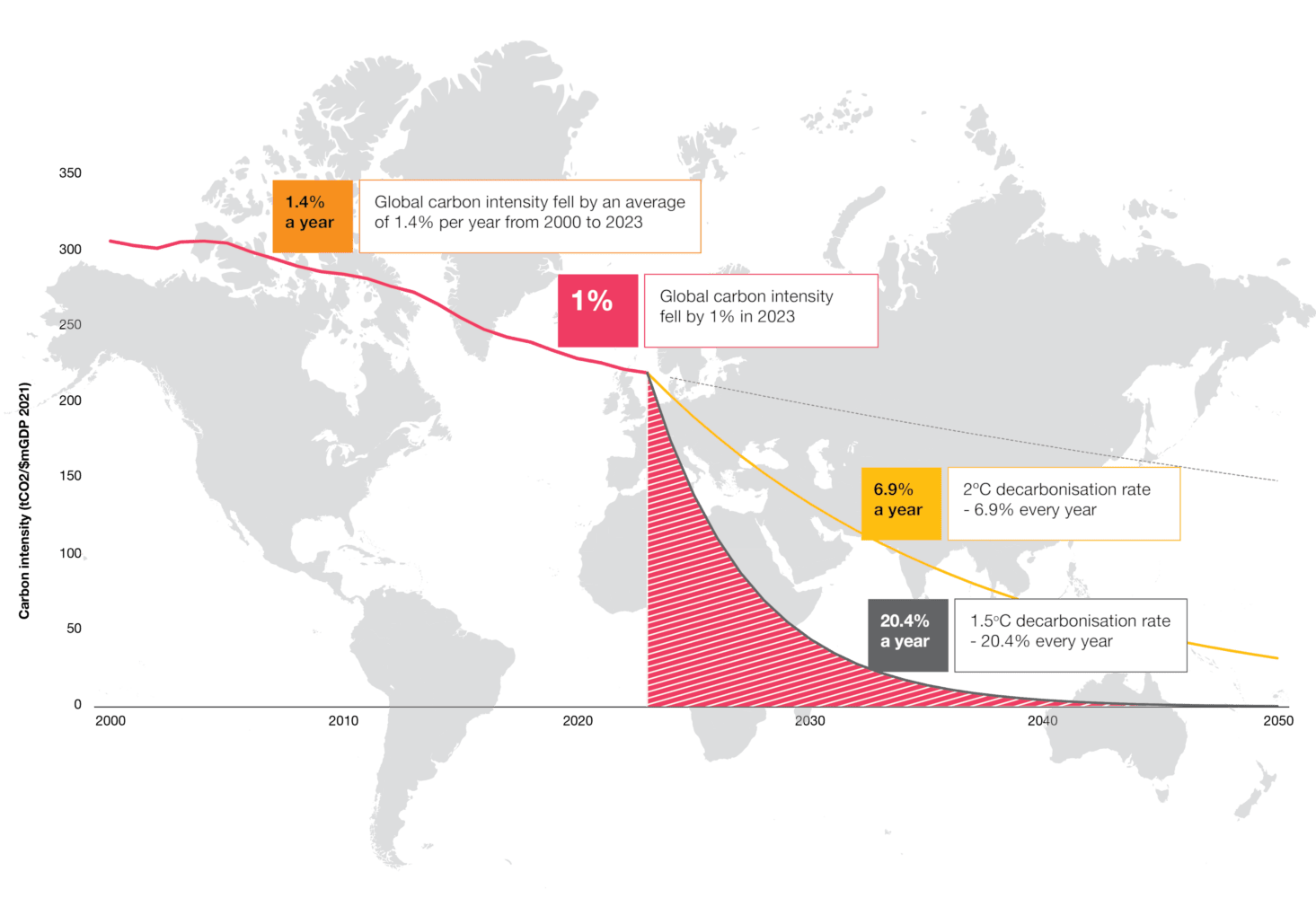
From milestones to exponential momentum: the path to net zero
Ireland stands at a pivotal moment in its journey towards a net zero economy. Emissions fell below 1990 levels for the first time in 2023, achieving the greatest year-on-year reduction since the economic recession of 2009–2011. However, we are still not on track to meet our national or EU emissions reduction targets for 2025 or 2030. The gap we need to bridge is significant and requires immediate, intensified efforts across all sectors. Time is running out to turn incremental progress into exponential change and ensure a sustainable and resilient future for all.
Global progress is stalling: the need for accelerated action is critical
Our latest Net Zero Economy Index reveals a troubling stall in global decarbonisation efforts. The reduction in carbon intensity slowed to just 1.02% in 2023, the lowest level in over a decade. As we approach the 1.5°C threshold, it is more urgent than ever to intensify our efforts. Achieving the required targets necessitates accelerating decarbonisation to 20.4%, a twenty-fold increase from current rates. This step change in effort is crucial to meet our global climate goals.
While 2023 was a milestone year for emissions reductions in Ireland...
The Government is committed to ambitious near-term carbon reduction targets and sectoral carbon budgets, which align with longer-term net zero economy ambitions. This commitment is putting pressure on companies and wider society to navigate the complex shift to a low-carbon economy. Evidence suggests that this shift is slowly starting, but significant challenges remain.
The latest emissions inventory and projections from the Environmental Protection Agency (EPA) show Ireland’s greenhouse gas emissions decreased by 6.8% in 2023. This milestone marks the first time emissions fell below 1990 levels. The EPA attributes this decline to effective climate action and decarbonisation measures, noting it as the largest reduction in emissions outside of a recession.
...we’re not on track to meet our national or EU commitments
While 2023 emissions reached their lowest level in three decades, and Ireland achieved its largest year-on-year reduction in emissions since the economic recession of 2009–2011, the EPA’s most recent assessment of Ireland’s progress towards meeting our national and EU targets is stark. While Ireland has separate national and EU emissions reduction targets and timeframes, the emissions gap that needs to be bridged is significant and requires immediate, intensified efforts across all sectors. Accelerating incremental progress into exponential change is crucial, as time is running out to ensure a sustainable and resilient future for all.
Sectoral decarbonisation needs to accelerate
Emissions in 2023 were only 7.8% below 2018 levels, falling short of the trajectory required to meet our national climate ambition of a 51% reduction by 2030, relative to 2018. The scale of the decarbonisation challenge is evident in Ireland’s struggles to stay within the limits of its carbon budgets.
The Government’s first two carbon budgets (2021–2025 and 2026–2030) were designed to align with the 2030 target. The EPA notes that with 63% of the first carbon budget already used, Ireland now needs annual emissions reductions of 8.3% from 2024–2025. This represents a significant uplift of 22% compared to the decarbonisation rate achieved in 2023, which was 6.8%.
Carbon budget 1 (2021-2025) – 295 Mt CO2eq.
Source: Ireland’s Provisional Greenhouse Emissions 1990 – 2023 (EPA 2024)
If the first carbon budget is breached, any excess emissions must be carried over, reducing the second carbon budget accordingly. The EPA highlights that Ireland is likely to exceed the first carbon budget by 9%, making compliance with the second budget challenging.
When the carbon budgets were designed, the second budget (2026–2030) required average reductions of 8.3%. However, if the second budget is reduced due to breaches of the first budget limits, higher and more challenging decarbonisation rates will be needed.
The EPA currently projects that Ireland will exceed the first two carbon budgets by up to 27%.
Ireland's carbon budgets
Source: Ireland’s Greenhouse Gas Emissions Projections 2023 - 2050 published by the Environmental Protection Agency, May 2024
To support the delivery of the carbon budgets, the Government established a series of legally binding sectoral emissions ceilings. These ceilings set the maximum greenhouse gas emissions permitted in different sectors for each carbon budget, with associated reduction targets relative to 2018. For example, the electricity sector’s ceiling requires a reduction in emissions by 40% by 2025 and 75% by 2030.
Sectoral decarbonisation reduction requirements
Sector |
2018 Emissions (MtCO2eq.) |
2021 – 2025 | 2026 – 2030 | |||
|---|---|---|---|---|---|---|
| Sectoral Ceiling (MtCO2eq.) | Indicative Sectoral Reduction 2025 (Relative 2018) | Sectoral Ceiling (MtCO2eq.) | Indicative Sectoral Reduction 2030 (Relative 2018) | |||
| Electricity | 10.24 | 40 | -40% | 20 | -75% | |
| Transport | 12.31 | 54 | -20% | 37 | -50% | |
| Buildings (Residential) | 7 | 29 | -20% | 23 | -40% | |
| Buildings (Comm & Public) | 1.55 | 7 | -20% | 5 | -45% | |
| Industry | 6.95 | 30 | -20% | 24 | -35% | |
| Agriculture | 21.39 | 106 | -10% | 96 | -25% | |
| Other | 2.14 | 9 | -25% | 8 | -50% | |
Sources: Ireland’s Provisional Greenhouse Gas Emissions 1990 – 2023 (EPA 2024)
The EPA highlights significant differences in rates of sectoral decarbonisation from 2018 to 2023. While the electricity and residential sectors have achieved decarbonisation rates exceeding 20%, Ireland’s two largest sectors — agriculture and transport — have seen the lowest percentage reductions in emissions (2.9% and 4.2% respectively since 2018).
Sectoral decarbonisation (2018 – 2023)
| Sector | 2018 Emissions (MtCO2eq.) | 2023 Emissions (MtCO2eq.) | Sectoral Decarbonisation Rates (2018 - 2023) |
|---|---|---|---|
| Electricity | 10.24 | 7.56 | -26.20% |
| Transport | 12.31 | 11.79 | -4.20% |
| Buildings (Residential) | 7 | 5.35 | -23.60% |
| Buildings (Comm & Public) | 1.55 | 1.41 | -8.90% |
| Industry | 6.95 | 6.29 | -9.60% |
| Agriculture | 21.39 | 20.78 | -2.90% |
| Other | 2.14 | 1.83 | -14.60% |
Source: Ireland’s Provisional Greenhouse Gas Emissions 1990 – 2023 (EPA 2024)
To avoid exceeding the first carbon budget, EPA analysis indicates that ambitious annual emissions reductions are required for 2024–2025 in the electricity (10%), industry (14%), transport (12%), commercial and public buildings (3%), and other sectors (5%). The residential sector is on track to meet its 2025 target. The EPA notes that the agriculture sector could potentially meet its 2025 target due to updates in Ireland’s emissions inventory from 2018 to 2023, which now identify a sectoral reduction of 8.5 MtCO2e.
However, the EPA warns that the national climate objective of a 51% reduction by 2030 will not be achieved unless all sectors meet their indicative reductions. This underscores the need for sectoral ceilings to be updated to reflect emissions inventory updates.
Sectoral ceiling emissions target gaps (2023 - 2025)
Source: Ireland’s Provisional Greenhouse Gas Emissions 1990 – 2023 (EPA 2024)
Missed climate targets will be costly
Ireland’s 2030 target under the EU’s Effort Sharing Regulation (ESR) is to achieve a 42% reduction in emissions by 2030, compared to 2005 levels, with annual binding emission allocations over the 2021–2030 period. However, EPA projections currently show Ireland achieving only a 9% to 25% reduction on 2005 levels, falling significantly short of the 42% target. Ireland’s Climate Change Council has warned that the cost of not meeting our EU ESR targets could exceed €8 billion.
“The EPA’s projections show that full delivery of all climate action plans and policies could deliver a 29% reduction relative to 2018 in greenhouse gas emissions. This is well short of both our European and national emission reduction targets and highlights the scale of effort required to achieve the required reductions across all sectors of our economy. The key priority must be to translate the aspiration in our policies and plans to implementation on the ground.”
Key actions businesses can take today
Establish an accurate emissions baseline
With the increased focus on decarbonisation, organisations need to develop or enhance existing decarbonisation and net zero strategies. Accurately assess your full carbon footprint using accepted methodologies to determine Scope 1, 2 and 3 emissions. Understanding the material factors driving these emissions will provide clarity on where the challenges lie.
Understand your operating environment
Once you have clarity on your emissions, consider your regulatory and commercial operating environment. How will the Corporate Sustainability Reporting Directive (CSRD) requirements impact your decarbonisation strategy? Are regulatory or policy changes anticipated? What commitments are your peers making? What do your customers expect? This will inform how quickly you need to adapt.
Set your strategy
Businesses should set ambitious emissions reduction targets and develop comprehensive climate transition plans. Set long-term and short-term targets to provide milestones for your decarbonisation and net zero journey. Understand the risks and opportunities resulting from these targets. Enhance climate resilience by identifying and mitigating climate-related risks. Senior leadership sponsorship and aligning corporate strategies with net zero ambitions are critical.
Collaborate externally
Form partnerships across industries and supply chains to promote energy intensity reduction policies. Engage in industrial clusters to adopt circular business models and advocate for lower energy and emission intensities. Enhance collaboration across the value chain through initiatives like demand substitution, demand consolidation and flexible demand response. Assist smaller enterprises in the supply chain by providing support, resources and technologies to help them reduce energy consumption and emissions.
Inform policymakers
Send strong signals to policymakers to support critical areas, reduce participation barriers, create competitive markets, and offer incentives and tax reliefs.
We are here to help you
The window for action to avoid triggering irreversible climate tipping points is closing. Immediate and sustained efforts are crucial to turn incremental progress into exponential change. Wherever you are on the journey to net zero, we are here to support you. If you’d like to discuss any aspect of these insights further, our team is ready to help. The time to act to secure a sustainable and resilient future is now.














Menu